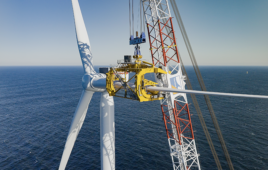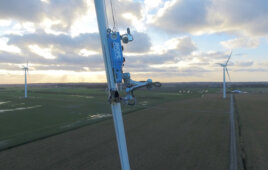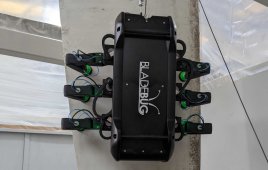Smalls drops, big impact: Even just minor rain erosion damage on rotor blade surfaces can impair performance and shorten the service life of wind turbines. This is according to research and development institute, Fraunhofer Iwes, which has launched a three-year study into the effect of rain erosion on wind-turbine blades. Fraunhofer has been operating a rain erosion test bench since 2015 to achieve a better understanding of how damage progresses and derive effective preventative measures.

Fraunhofer compares turbine-blade material samples with different coatings after a rain erosion test to show how each sample measures up.
Within the scope of the organization’s new “BeLeB” research project, the aim is to contribute to the development of reliable forecasting models for erosion damage and apply them to turbine operation. In particular, this encompasses the assessment of practice-relevant repair concepts. To achieve these goals, Fraunhofer says that the test bench is set up to enable continuous testing and precise damage documentation by means of high-resolution 3D images. Offshore operating data will be used by way of comparison for validation purposes.
The blades
During operation, the wing tip of a wind turbine can reach speeds of 300 to 350 km/h and, as a result, rain drops and pollution in the air act like sandpaper on the surface of the material. Parts which are subjected to particular stresses, such as the leading edge of blades, are finished with protective systems such as paint and coatings. The development and validation of a method for the accelerated service life analysis of coating systems helps to prevent turbine downtimes and loss of profits.
To this end, as part of the BeLeB research project (development of a method for determining the service life of rotor blade coatings), tests will be performed on the Fraunhofer Iwes test bench. These will be compared against the measurement data from a long-term study of selected turbines on which a certain coating material is used on the blades.
The comparison of damage progression on the test bench and damage documentation from operational offshore turbines guarantees that the test bench reproduces the most realistic conditions possible and that the effectiveness of protective mechanisms can be simulated reliably over accelerated time periods. This allows the development of practical preventative measures.
The drop impact
Both the amount and size of the drops as well as the timing and frequency of their impact can be regulated precisely on the rain erosion test bench. Moreover, over the course of the three-year BeLeB project, a drop impact system will measure exactly where the drops hit and the damage they cause. The entire test bench is modeled for this with the aid of a CFD simulation.
A laser-based inspection system and a high-speed camera are used to document the damage, whereby both the topology of the sample and damage in the micrometer range are recorded. The development of an adequate material and damage model will improve understanding of the processes at material level. For material suppliers, both these aspects are of great interest for rotor blade production so as to enable them to adapt their products to the practical requirements in the best possible way.
The goal of the project partners is to improve the effectiveness of known protective mechanisms for rotor blades tangibly. They hope this will reduce the time and money invested in repairs and maintenance. This would represent a major step forward in ensuring the improved profitability, and therefore enhanced competitiveness of wind energy. The provision of effective rain erosion protection is not only of great interest to operators and maintenance companies, but also to suppliers of protective systems and manufacturers of matrix resins and gel coats.
To read more about the research, click here.
Filed Under: Blades, O&M




